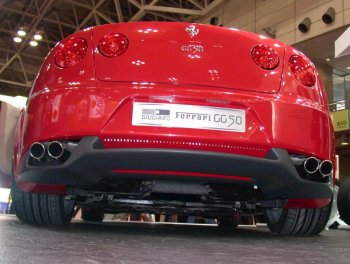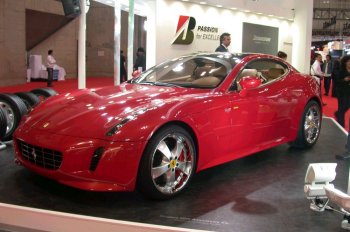|
Unveiled at the 39th Tokyo
Motor Show this morning, the Italdesign-Giugiaro Ferrari GG50 is
definitely one of the stars of the show.
As the GG50 name
suggests, the concept car celebrates Giorgetto Giugiaro’s 50
years as a professional car designer. It also marks the
first time that Giugiaro has designed and built a prototype
car specifically for himself. The master designer explains,
“To mark 50 years of activity in the world of car design, I
decided to sculpture a Ferrari to the memory of that great
adventure and enjoy it with my family”.
This is the reason why the
GG50 is an expression of current design trends, rather than
a futuristic fantasy. The Ferrari, which is graced by his
initials, GG, followed by the digit 50, is a way of
epitomising Giorgetto Giugiaro’s debut into the world of
automotive design in September 1955. The concept calls on
the key philosophies set forward by Giugiaro, namely
unmistakable form with class leading ergonomics and
outstanding interior space. The GG50 is based on the Ferrari
612 Scaglietti, retaining the same basic mechanicals such as
the 540bhp V12 5,748cc engine and running gear. Despite
this, the Ferrari GG50 is a little shorter in length than
the 612, with a fastback tail introduced to camouflage the
concept’s functional hatchback boot lid.
Giugiaro’s idea of creating a
Ferrari to mark his 50th anniversary as a car designer, took
shape during the Paris Motor Show in September 2004. It was
at this event where Giorgetto Giugiaro described his dream
directly with Ferrari President and CEO, Luca di Montezemolo,
who told the Italian master designer to develop his vehicle
concept around the 612 Scaglietti V12 2+2 coupé. Montezemolo
also provided two design strategies: although no
restrictions were to be applied to creativeness, the car
should be inline with Ferrari’s tradition, and transmit a
sensation of compactness to underline the enjoyable driving
experience gained behind the wheel of a Ferrari.
The project was started in
February 2005, when Giugiaro started sketching the physical
form of the car by hand in 1:10 scale from four orthogonal
views. The side, nose, tail and plan view were all sketched
out in 2H lead pencil on tracing paper using a universal
chalkboard. This two-dimensional rendering is typical of
Giugiaro’s method, representing a practice which he has
followed for the past 50 years. Today, the method is pursued
by Giorgetto’s son, Fabrizio Giugiaro, who is Italdesign
Giugiaro’s Styling Area Director. The 2d rendering was then
translated into mathematical surfaces on CAD/CAS software,
and then projected as a 1:1 scale dynamic visualisation in
the Italdesign-Giugiaro Virtual Reality Design Center. After
the Virtual Reality go-ahead was given, a full-scale plaster
model was milled and completed in April. Using the 1:1 scale
model mock-up, studies got underway to facilitate ergonomics and
the ease-of-access for the interior concepts. Construction of
the running prototype was initiated at the beginning of
June.
A new layout
Although the GG50 retains the
612 Scaglietti wheelbase of 2.95 metres, the one off is 4.81
metres in length and therefore 9 centimetres shorter than
the production model. The front overhang was shortened by
two centimetres, with the majority of shortening being
concentrated on the rear end. With the standard 612
Scaglietti, the fuel tank is positioned vertically behind
the rear seats. In the case of the Ferrari GG50, Italdesign
engineers were faced with the task of positioning a new
95-litre fuel tank entirely below the boot line. This detail
was overseen and supported by the Ferrari Technical
Direction. When the rear seatbacks are folded down, the
redesigned fuel tank layout provides a flat loading platform
1.40 metres deep. This increases the 240-litre loading
capacity of the 612 Scaglietti to 270-litres, which can be
further expanded to 500 litres with the rear seatbacks
folded.
It was this improved loading
space, which left Giugiaro to decide on using a proper
hatchback boot lid, hinged to the roof edge. In order to do
so, Italdesign engineers had to redesign the rear
cross-member, which in the standard Scaglietti joins the
suspension strut domes atop the fuel tank. A cross-member
was also added to the roof edge and was joined to two
reinforced risers to take the additional weight of the
hatchback door.
GG50 Exterior Design
Despite being 9 centimetres
shorter in length than the 612 Scaglietti, the Ferrari GG50
concept instantly appears to be even more compact due to its
subtly rounded nose and tail sections.
Giugiaro explains, “In bird’s
view, all cars look like a rectangle. As a consequence, the
dimensions are perceived optically as being the same as the
maximum length.” With the GG50, Giugiaro rounded the
sections between the front and rear wheelhouses to form
extreme loops at the nose and tail. “When viewed from
three-quarter angles, this also enhances the look of the car
optically, making the car appear leaner and bolder. In a
nutshell, rather than having a fender lip that clearly
defines the bodyside edge, a seamless line flows toward the
centerpoint where the two extremities meet”.
|
 |
|
"To
mark 50 years of activity in the world of car
design, I decided to sculpture a Ferrari to the
memory of that great adventure and enjoy it with my
family," commented Giugiaro |
|
 |
|
|
 |
|
Unveiled at the 39th Tokyo Motor Show today, the
Italdesign-Giugiaro Ferrari GG50 is definitely one
of the biggest stars |
|
 |
|
|
The fastback shape not only hides the hatchback design, but
it also provides more interior space for occupants in the
rear and conceals the +2 seating to give the impression of a
true two-seater. The side view is characterised by the air
intake which provides cool air for the front brake system.
The lines flowing from the intake, stream towards the rear
almost parallel with the ground line and creates a
bas-relief which fades away towards the rear. The pillarless
glasshouse area, framed with stainless detailing, helps to
provide an elegant look, and further helps disguise the 2+2
seating layout.
As with Ferrari’s most stunning cars, such as the 250 GTO,
the belt line arches in correspondence to the rear wheel,
highlighting the extreme power fed through the rear axle. As
Ferrari tradition calls, the LED dual tail lamps are round,
although are in this case asymmetrical with the inner lights
being of a smaller diameter. Adding to this, Italiaspeed are
keen to point out that the rear design gives a strong
indication to next year’s Alfa 147 replacement, which is
scheduled for the Paris Motor Show. We therefore cannot
ignore but question as to whether Giugiaro’s “free hand” was
more compromised and politically guided than he publicly
made out.
The front displays a simple
and delicate view, with the low-slung Ferrari grille being
as unmistakable and passionate as ever. A hint of Formula
One and Enzo is shown in the middle of the bonnet, where a V
shape flares forward in the centre. Alongside the
traditional Ferrari grille are two complimentary vertical
air intakes, above which the fog lights are housed behind
glass sections. Simplistic, vertical headlights continue
Ferrari’s current theme first presented on the Pininfarina
Rossa concept. The units house Xenon headlight beams and
dimmers, along with the indicators. The bulk of the bobtailed
rear end has been reduced with a black-painted undersection
which houses the quad-pipe stainless exhaust system. The
chrome Prancing Horse logo, set against the blood red
metallic paintwork, is set at the forefront of the design. A
small integrated spoiler at the crest of the lower hatchback
section, provides extra downforce to ensure greater
stability at high speeds. The hatchback design is perfectly
concealed, and is further complimented by the photochromatic
glass roof.
GG 50 Interior Design
Whereas the GG50’s exterior
design was the result of an emotional pencil sketch, the
interior was fashioned as the full-scale mock-up progressed.
The interior largely retains the appearance of the
Scaglietti, but the claustrophobic sensation in the rear was
eliminated by sloping the rear window at the side.
“Getting in and out of a 2+2
coupé is never an easy feat, because access is directly
proportional to the door’s length, which cannot be stretched
to the infinite. Indeed, the GG50 door’s structural frame
mesmerises the Scaglietti’s door framework. However,
enhanced headroom has been gained by sloping the rear
window, thereby making it much easier to get in and out of
the car than expected. Just try getting in and out of the
car and you’ll see how easy all this can be”, explains
Giugiaro.
More concentration was
applied to the driver’s right hand, traditionally used to
change gear. On the 612 Scaglietti, the F1 gear change is
fitted behind the steering wheel, and leaves more options
open for the right hand. As a result, many commands and
controls traditionally found on the left-hand side of a
Ferrari LHD steering wheel, such as lights and electronic
handbrake, are now relocated in the centre of the cockpit.
The instrument binnacle is the same as on the Pininfarina
designed production car, but the dashboard is entirely new.
Centre of attention is given to the AVIC-X1R satellite
navigation system by Pioneer. Two generous storage pockets
are located between the front and rear seats, both protected
by a flap. The door panels, which also feature large storage
pockets, are finished with a horizontal natural beech
insert. The re-trimmed beige leather seats use the
structural frames found in the production car.
Underbonnet design has also
been tackled, featuring a mix of silver, dark gray and gauze
covered sections. The legendary red craquelure cylinder
heads of the 5.7 V12 engine remain visible.
There are no plans for
Ferrari to produce this prototype in serial form, but the
conclusion immediately drawn by onlookers at the Tokyo Motor
Show was that the GG50 is a practical, production orientated
sportscar, rather than the wild, fantasy showcar that one
might expect Giugiaro to have fashioned in order to
celebrate this half century milestone in style and
achievement. For that reason it would appear that Giugiaro -
regarded by many in the automotive industry as the world's
greatest living car designer - has created a serious
"product pitch", and has one eye cast over Pininfarina's
turf...
|
|
|
|
![]()
![]()